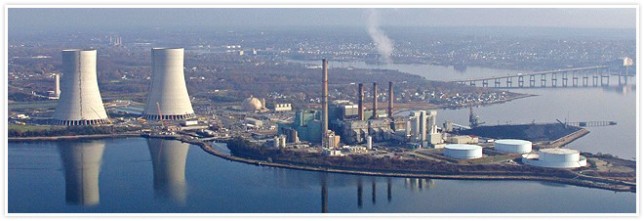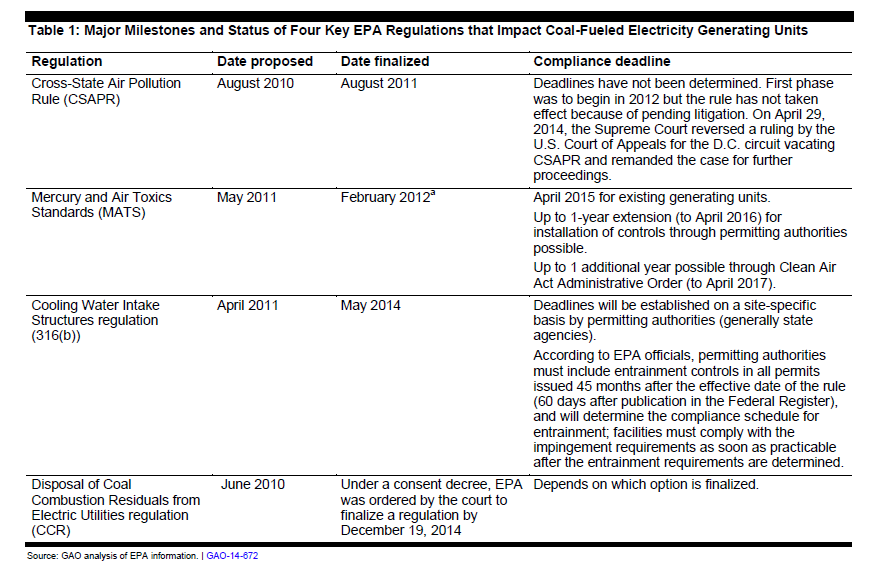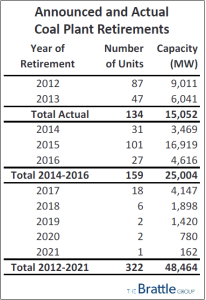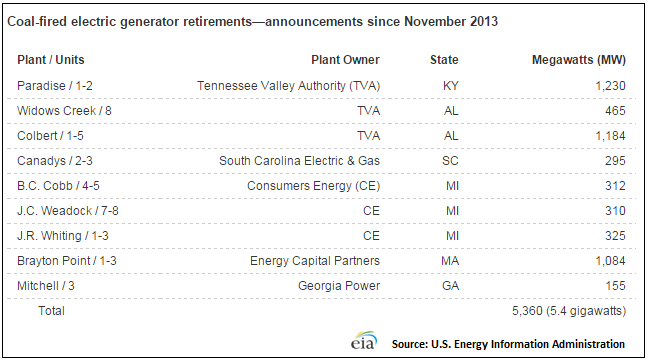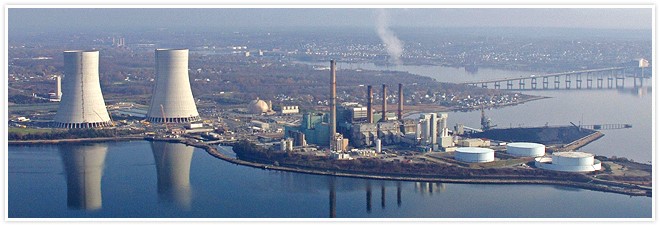The coal power industry is under pressure from numerous fronts. Against a background of soft demand, competitive natural gas prices and growing capacity from renewables, the coal power industry is facing a series of major environmental regulations that are forcing power plant owners to either invest in major upgrades or shut down underperforming plants.
New Environmental Regulations
The single biggest variable impacting the coal industry in 2015 is new EPA emissions rules. While the proposed new Clean Power Plant rules intended to reduce CO2 emissions have gotten the most attention in the media, the lesser known MATS (Mercury and Air Toxics Standards) rules are having a much bigger impact on the industry this year.
MATS regulations require coal-fired power plants to make significant reductions in emissions of mercury, acid gases, and toxic metals. The standards go into effect in April 2015, but this deadline may be conditionally extended by up to one year by state environmental permitting agencies. It is expected that 90% of the coal power plant retirements will occur by 2016, within the first year of enforcement for MATS.
To comply with MATS coal power plants must have expensive flue gas desulfurization equipment (scrubbers) or dry sorbent injection systems installed by 2016. The rule calls for strict emissions limits and does not have any provisions for trading of allowances. Emissions limits are to be strictly applied to each individual plant, and noncompliant plants need to have new emissions control equipment installed or be retired. Numeric limits are mandated for mercury (Hg), metals, particulate matter (PM), and acid gases: hydrochloric acid (HCl) and sulfur dioxide (SO2).
In addition to MATS there are other pending rules impact coal power. The Regional Haze Program is intended to improve visibility and has similar technical requirements to MATS. The Cooling Water Intakes Structures regulation, 316(b), concerns the use of screens to filter water used for cooling systems. There are also new rules covering disposal of coal ash and the Cross State Air Pollution rule has been struck down for now but will be revised. Financial impacts of these rules are minor compared to MATS and are not expected to lead to additional plant retirements beyond those resulting from MATS compliance.
The other biggest emissions rule that in the works that could lead to additional closures are the proposed CO2 rules under the Clean Air Act (111(b) and 111(d)). The CO2 rules have not been finalized and will face legal challenges, but could generate as much as another 50 GW of plant closings by 2020.
Coal Power Plant Retirements
Energy consultants, The Brattle Group, have documented 33 gigawatts of coal capacity that have been announced for retirement between 2014 and 2021, on top of another 15 GW that were retired in 2012 and 2013. These retirements are primarily in response to the MATS rules. The power plants that are most likely to be shut down due to MATS are the oldest and dirtiest that are most difficult to upgrade, especially the plants that are used less and have lower capacity factors.
The US EIA (Energy Information Administration) has projected that between 2012 and 2020 about 60 GW of coal fired capacity will be shut down in response to the new MATS standards. Retirement decisions are based on the relative economics and regulatory environment of the electricity markets. A plant may retire if higher coal prices, lower wholesale electricity prices, or reduced utilization make investment in equipment like scrubbers uneconomical.
The Tennessee Valley Authority (TVA) announced on Nov. 14, 2013 that it was retiring eight coal fired units amounting to nearly 3,000 megawatts of generating capacity. Among the retirees are two units at TVA’s Paradise Fossil Plant (1,230 MW), Unit 8 at the Widow’s Creek Fossil Plant (465 MW), and all five units at the Colbert Fossil Plant (1,184 MW). Many of the units had already been idled. These retirements come on top of 1000 MW of previously announced retirements in 2011.
Paradise Unit 3, one of TVA’s largest coal units, will continue to operate. TVA conducted detailed analyses including an Environmental Assessment to review options for meeting stricter air quality regulations at the Paradise plant, including installing additional emission controls on Units 1 and 2, building a new gas-fired generating plant at the site or taking no action.
In August 2012, the TVA Board approved a project budget for environmental controls for Paradise units 1 and 2, but significant changes in TVA’s business environment required TVA to re-evaluate that decision. Based on that review, the board approved the construction of a gas-fired plant at Paradise. This will result in an investment of approximately $1 billion at the site. The two coal units will be retired when the gas plant is available.
The environmental assessment for the Paradise Plant considered three options: taking no action, installing emissions controls on Units 1 and 2, or building a new natural gas fired generating plant at the location. The risks and benefits considered were an economic evaluation, construction costs, anticipated future regulations, impacts on employees, and impacts on the local community. The TVA Board decided that building a gas plant was the best long-term solution when all the benefits and risks were weighed.
At the Colbert and Widows Creek sites, TVA was under agreement with the EPA to either install certain environmental controls, retire the units or convert the units to gas. Economic evaluations indicate investment in additional emission controls would not be as economically beneficial as retiring Colbert units 1-5 and Widows Creek unit 8. Retiring these units would avoid capital costs of $1.01 billion and $163 million for controls at Colbert and Widows Creek, respectively.
These steps move TVA toward a more balanced generation fleet of about 40 percent nuclear, 20 percent coal, 20 percent gas and 20 percent hydro, renewables and energy efficiency.
South Caroline Electric & Gas (SCEG) announced that it would cease operations at its Canadys Station coal power facility in November, 2014. The decision to close the 295 MW plant is based on efforts to reduce emissions and comply with MATS regulations coming into effect in 2015. SCEG had one time planned to convert the plant to natural gas and retire it in 2018, but that decision was changed to immediate retirement.
Consumers Energy (CE) sought a bond issue from the Michigan Public Service Commission (MPSC) to cover the costs of decommissioning and demolition of three coal fired power plants. The facilities, Units 4 and 5 of the B.C. Cobb Plant (312 MW), Units 7 and 8 of the J.C. Weadock Plant (310 MW), and Units 1, 2, and 3 of the J.R. Whiting Plant (325 MW), will cease operations by April 2016. CE stated that the units would be shut down because the installation of additional emissions controls necessary to achieve compliance with EPA regulations would be uneconomical.
New Jersey based Energy Capital Partners (ECP) filed paperwork with the Independent System Operator of New England (ISO-NE) to close the Somerset, Massachusetts Brayton Point coal power plant in 2017 after it failed to reach a deal on a new power purchase agreement. At 1,557 MW, Brayton Point is currently the largest fossil fueled power plant in New England and went into service in 1963. Brayton Point currently has operating agreements with ISO-NE through May 30, 2016. Three of the four Brayton Point generating units, totaling about 1,084 MW, are coal-fired, the remaining 435 MW of generator capacity are powered by oil or natural gas. ECP had just recently finalized the purchase of the 1,520-MW facility from Dominion Resources in September 2013.
The decision to close Brayton Point Station was completely economic since the plant already had received investments of $1.28 billion in environmental controls. Brayton Point was the cleanest coal powered facility in ISO-NE, though still a major polluter. The plant employs scrubbers, selective catalytic reduction (SCR), and an ash reduction process that enabled the station to recycle nearly 100% of its ash. The plant had met all requirements included in a consent decree with the EPA concerning emissions of SO2, NOx, mercury, water use and heat discharge into Mount Hope Bay. Brayton Point is also an active participant and contributor to RGGI (Regional Greenhouse Gas Initiative), one of only two CO2 cap and trade programs in the USA.
Brayton Point photo by ECP
Georgia Power (GP) announced that it planned to file a request with the Georgia Public Service Commission (GPSC) to decertify Unit 3 at its Mitchell generating facility. If approved by the GPSC, GP plans to retire the 155-MW unit before the end of April 2015. GP had proposed to convert the unit to use biomass, but the conversion was determined not to be cost effective.
Georgia Power is in the midst of a significant transition to its generation fleet. As part of its 2013 Integrated Resource Plan (IRP), the company received approval from the PSC to decertify and retire more than 2,000 MW of coal and oil fired generation at facilities across the state. Georgia Power continues to add cost-effective renewable generation to its portfolio. By 2017, the company is expected to have more than 2,300 MW of generation from renewable sources in operation or under contract including hydro, biomass, landfill gas, solar and wind generation. The company recently added 250 MW of wind generation to its portfolio and will soon have nearly 800 MW of solar capacity under contract.
In 2012 there were approximately 310 GW of coal-fired electrical generating capacity available in the USA from 1,308 generating units and it is expected that roughly one-fifth of that capacity will be shut down by MATS. In 2012, 10.2 GW of coal-fired capacity was shut down.
Coal-fired units that were retired in 2010-2012 were small, with an average size of 97 MW, and inefficient, with an average tested heat rate of around 10,695 Btu/kWh. In contrast, units scheduled for retirement over the next ten years are larger and more efficient at 145 MW with an average tested heat rate of 10,398 Btu/kWh. Most of the units being retired are older, smaller, more polluting and used less extensively. Though there are some exceptions where large plants are being retired such as the Brayton Point plant in MA. Additionally, most of the capacity being retired is geographically concentrated in four states: Ohio (14 percent), Pennsylvania (11 percent), Kentucky (7 percent), and West Virginia (6 percent).
Choosing to Retrofit or Retire
Whether choosing to retire, upgrade or replace an existing facility, plant owners face a complex set of choices in determining the best course of action. Many steps factor into the complete decommissioning and retirement of a coal-fired facility, from asset valuation and cost studies to deconstruction scoping, site remediation and possible redevelopment. For example, cost estimates should reflect the full scope of work required including structural demolition and scrap recovery as well as environmental cleanup costs and site restoration. Many coal-fired power plants occupy prime real estate along rivers, in or near downtown areas, and feature rail access, roadways, water, sewers and other utilities.
Conversion to gas-fired generation is very appealing since a combined cycle plant requires significantly less space than coal-fired structures spread over hundreds of acres. Today’s natural gas-fired combustion turbine power plants also convert fuel energy to electricity at a more efficient conversion rate than conventional, older coal-fired or natural gas-fired steam power plants, at less than 7,000 Btu/kWh instead of greater than 10,000 Btu/kWh, and they do it with lower operating and maintenance costs.
An alternative to a new gas turbine is to keep the old boilers and steam systems in place and simply repower the plant with gas. This option often makes financial sense because so much equipment and infrastructure is already in place, including transmission lines, substations and water.
Three options must be considered in retrofitting a decommissioned plant with newer, more efficient technology. Can existing equipment be economically retrofitted, either by converting the boilers to burn gas or installing a combustion turbine in combined cycle with the existing steam turbine? Can the site be reused by using all-new equipment to take advantage of existing infrastructure? Or should the site be abandoned and sold and a new plant built elsewhere?
Some of the technical factors that are considered when deciding if a coal plant is suitable for scrubber upgrades include the heat rate and the age of the plant. Units that have higher heat rates, i.e. units that require greater than 10,000 Btu for each kWh produced are costlier to operate and also have higher CO2 emissions. While CO2 emissions are not explicitly regulated today, the EPA has already announced plans to control them under the Clean Air Act. Even though the Clean Air Act does face legal and political challenges, prudent executives assume that some form of CO2 emissions regulations will be forthcoming within the operational time frame of their power plants.
All power plants require maintenance as they age, and decades old coal plants are particularly expensive. Executives must consider the costs of emissions control upgrades in addition to routine operational maintenance costs. Older and more antiquated become increasingly uneconomic when these costs are compared against a declining useful life.
Not all coal-fired power plants in service face the dilemma of installing the necessary emission control equipment. Of the approximately 310 GW of coal fired generating capacity in the U.S., about 150 GW already have installed the scrubbers. Another approximately 50 GW have scrubbers permitted or under construction. Thus only about one third of the U.S. coal-fired generating capacity, or about 110 GW, will have to decide whether to install the necessary control equipment or potentially shut down.
In many regions where coal-fired power plants are at risk of being shutdown there is a great deal of underutilized capacity in existing natural gas combined cycle plants (NGCC). Many of these NGCC plants were built as peaker plants whose purpose is to ramp up quickly to meet spikes in demand, but otherwise sit idle on the power grid. Many NGCC units are running at low capacity factors of 7% – 35% and could ramp up substantially if needed to meet the demand from retired coal plants.
Some plants scheduled for retirement may be placed on life support. Regional transmission organizations (RTOs), the entities which oversee the grid and electricity markets for different regions, have the power to order a plant to keep running even if it is not financially viable. In the past two years, MISO, the Midcontinent Independent System Operator, has ordered at least seven coal and gas-fired power plants to keep running, after designating them “System Support Resources” (SSR) and negotiating agreements to compensate the operators for the costs. Energy experts predict a flurry of SSR agreements in MISO in the next two years, driven by market forces and 2015 MATS deadlines.
“SSR designation is very much a last resort – but it is something we’re seeing much more of given MATS and other environmental regulation and other industry trends like gas prices,” said MISO spokesman Andy Schonert. “That has resulted in us seeing more of these (SSRs) and I don’t get the impression these will be going away any time soon.” With coal-fired units retiring, he added, the agreements “provide a backstop mechanism for the orderly exiting of such generation without disrupting grid reliability.”
Currently plants running under SSR agreements include the Presque Isle plant in Marquette, Michigan; Consumer Energy’s plant in Gaylord, Michigan; and plants in Escanaba and White Pine, Michigan. PJM Interconnection, the RTO covering parts of 13 states stretching from the Midwest to the East Coast (plus Washington D.C.), also has a similar process known as “Reliability Must Run” (RMR), currently covering First Energy’s coal plants in Cleveland, Eastlake and Ashtabula, Ohio.
Availability of Natural Gas Supplies
According to analysis by ICF, natural gas consumption could increase as much as 2 trillion cubic feet (Tcf) due to coal plant retirements. Most of the USA has adequate natural gas supplies and infrastructure to meet rising demand for gas. One notable exception is the North East where gas pipeline infrastructure is constrained. Lacey Girard, a spokeswoman for ISO New England, said the region can’t expect to easily replace coal with natural gas unless it expands pipelines. The lack of pipeline capacity has led to supply shortages and price spikes in the region during periods of peak demand, such as cold winter days.
Girard went on, “if these fundamental economic forces continue to push older, more expensive oil and coal-fired generators toward retirement, the region’s dependence on natural gas will only increase. And as the region has become more dependent on natural gas-fired generation, the natural gas pipeline infrastructure has grown increasingly constrained, resulting recently in much higher natural gas prices in New England than in other parts of the country.”
Last winter, system operators relied on several generators that will not be available for all or part of this winter. These include Salem Harbor Station, which on May 31, 2014, retired its two remaining coal and oil units totaling about 585 MW, and Vermont Yankee Nuclear station, which will retire its 615 MW of capacity by the end of 2014. Other generators, including the 350 MW oil-fired Norwalk Harbor Station, the 125 MW coal-fired Mt. Tom Station, and a unit totaling 150 MW at the Bridgeport Harbor Station are no longer providing power to the grid.
On winter days when natural gas pipelines have operated at full capacity, not enough gas has been available to serve all of New England’s natural-gas-fired power plants. In fact, while gas-fired resources together represent more than 11,000 MW of generating capacity, ISO New England’s operational experience has shown that during cold periods, the pipelines are capable of supporting less than half this amount.
NE-ISO has procured about 810 MW of electricity imports from neighboring power systems and more than 600 MW of demand-response resources that can be called on to reduce electricity use during tight system conditions. New England’s dependence on natural gas puts the region in a vulnerable position, especially during cold weather, because the current pipeline infrastructure cannot deliver all the gas required to serve both heating customers and power generators.
Most gas-fired generators do not have firm contracts for natural gas delivery and instead rely on the release of spare pipeline capacity from gas utilities. With increased residential and business conversions to natural gas for heating, spare pipeline capacity is often not available for power plants.
Last winter, periods of sustained cold weather boosted demand for natural gas, causing severe pipeline constraints that led to record-high natural gas prices. As a result, for much of winter 2013/2014, natural gas was often more expensive than oil, which is relatively uncommon. Because oil-fired generation was more competitively priced than the natural-gas-fired generation on many days, the oil fleet ran at higher-than-normal capacity through much of the winter; coal-fired generators also ran more often than usual. Most significantly, on certain cold days, the natural gas pipelines in New England were running at maximum capacity, but very few gas-fired generators were producing power, signaling that the gas was being used for other purposes, most likely to heat homes and businesses.
With the retirement of coal, oil, and nuclear power plants, the region’s reliance on natural gas to produce electricity is expected to increase.
